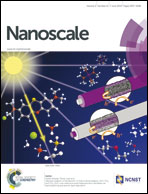Novel multi-layered 1-D nanostructure exhibiting the theoretical capacity of silicon for a super-enhanced lithium-ion battery†
Abstract
Silicon/carbon (Si/C) nanocomposites have recently received much attention as Li-ion battery negative electrodes due to their mutual synergetic effects in capacity and mechanical integrity. The contribution of Si to the total capacity of the Si/C nanocomposites determines their structural efficiency. Herein, we report on a multi-layered, one-dimensional nanostructure that exhibits the theoretical specific capacity of Si in the nanocomposite. Concentrically tri-layered, compartmentalized, C-core/Si-medium/C-shell nanofibers were fabricated by triple coaxial electrospinning. The pulverization of Si was accommodated inside the C-shell, whereas the conductive pathway of the Li-ions and electrons was provided by the C-core, which was proven by ex situ Raman spectroscopy. The compartmentalized Si in between the C-core and C-shell led to excellent specific capacity at a high current rate (>820 mA h g−1 at 12000 mA g−1) and the realization of the theoretical specific capacity of the Li15Si4 phase of Si nanoparticles (3627 mA h g−1). The electrochemical characterization and inductively coupled plasma-atomic emission spectrometry provided direct evidence of full participation of Si in the electrochemical reactions.


 Please wait while we load your content...
Please wait while we load your content...